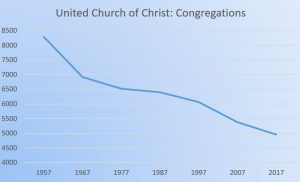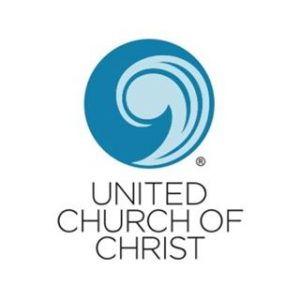 The United Church of Christ (UCC) was formed in 1957 as the result of the union of two Protestant denominations: the Evangelical and Reformed Church and the Congregational Christian Churches. In 1957 the UCC included 8,283 congregations with 2,193,593 members. Every decade since the formation has featured a decline in both total congregations and total members (statistical data sourced from the Fall 2018 edition of United Church of Christ: A Statistical Profile)
The United Church of Christ (UCC) was formed in 1957 as the result of the union of two Protestant denominations: the Evangelical and Reformed Church and the Congregational Christian Churches. In 1957 the UCC included 8,283 congregations with 2,193,593 members. Every decade since the formation has featured a decline in both total congregations and total members (statistical data sourced from the Fall 2018 edition of United Church of Christ: A Statistical Profile)
Declining Congregations
The total number of congregations in the UCC declined by 40.2% between 1957 and 2017.
Viewing the percent decline by decade highlights the shifts in the rate of decline
- 1
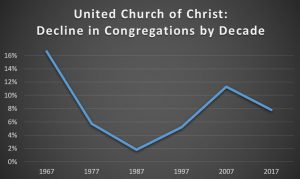 957-1967 – 16.6%
957-1967 – 16.6% - 1967-1977 – 5.7%
- 1977-1987 – 1.8%
- 1987-1997 – 5.2%
- 1997-2007 – 11.3%
- 2007-2017 – 7.8%
Declining Membership
Total membership within the UCC declined by 61.1% between 1957 and 2017.
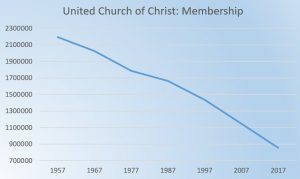 1957 – 2,193,593
1957 – 2,193,593- 1967 – 2,025,857
- 1977 – 1,785,632
- 1987 – 1,662,568
- 1997 – 1,438,181
- 2007 – 1,145,281
- 2017 – 853,778
Viewing the percent decline by decade highlights the shifts in the rate of decline
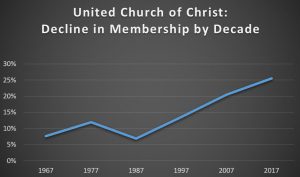 1957-1967 – 7.6%
1957-1967 – 7.6%- 1967-1977 – 11.9%
- 1977-1987 – 6.9%
- 1987-1997 – 13.5%
- 1997-2007 – 20.4%
- 2007-2017 – 25.5%
So What?
I’ve opted to report on the statistics in the United Church of Christ because it is a tradition that I belonged to since 2010. It is important to note, however, that this tradition’s decline over the last sixty years is quite similar to the decline that has occurred within Mainline Protestantism as a whole.
In addition to painting a detailed picture of the timing of decline for both congregations and membership, the data above highlights that the decline in membership has been far more dramatic than the decline in congregations (61.1% compared to 40.2% over the last sixty years). As a result, small congregations now comprise a greater percentage of all congregations than at any time in the history of the denomination.
Today is a day many celebrate the Reformation. It should be not only a time to recall history, but also an opportunity to continue the work of reforming in response to the leading of a Still Speaking God.
- Are you a part of the United Church of Christ or another Mainline Protestant tradition?
- If so, how have you been impacted by the last six decades of decline? How has your congregation?
- If not, what is the story of overall growth and decline within your tradition? How has this impacted you? your congregation?
- Given what you know, provide your estimate for the rate of growth or decline from 2017-2027 within the UCC for congregations and for membership. What are the top three factors that contributed to your thinking? What type of potential changes within the United States would be most likely to change you prediction?
For more of my writing about the decline in the UCC:
- Dwindling Membership: The United Church of Christ from 1965-2015 (Nov. 2016)
- More Decline in the Mainline: UCC in Florida (Feb.2012)
Both average congregational size and the percentage of congregations in the denomination’s largest membership category (1,000+) continue to decline. From 2007 to 2017 the percentage of congregations with at least 1,000 members declined from 1.5% to 0.9% (a 40% decline). I’ve been fortunate to be a part of the life of two congregations that are currently in the top 1% of all UCC congregations in the category of membership:
- Naples United Church of Christ (Naples, FL)
- Cathedral of Hope United Church of Christ (Dallas, TX)
